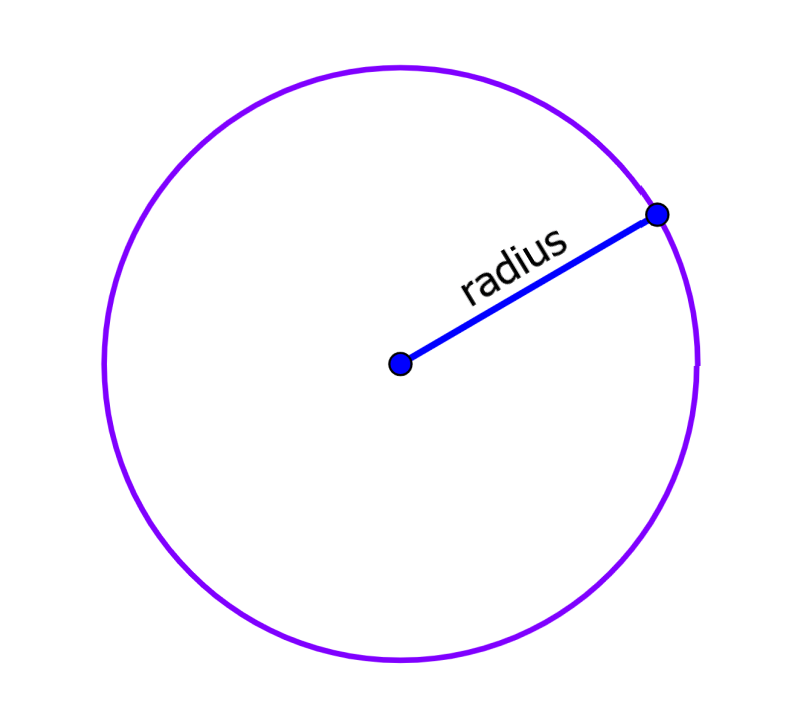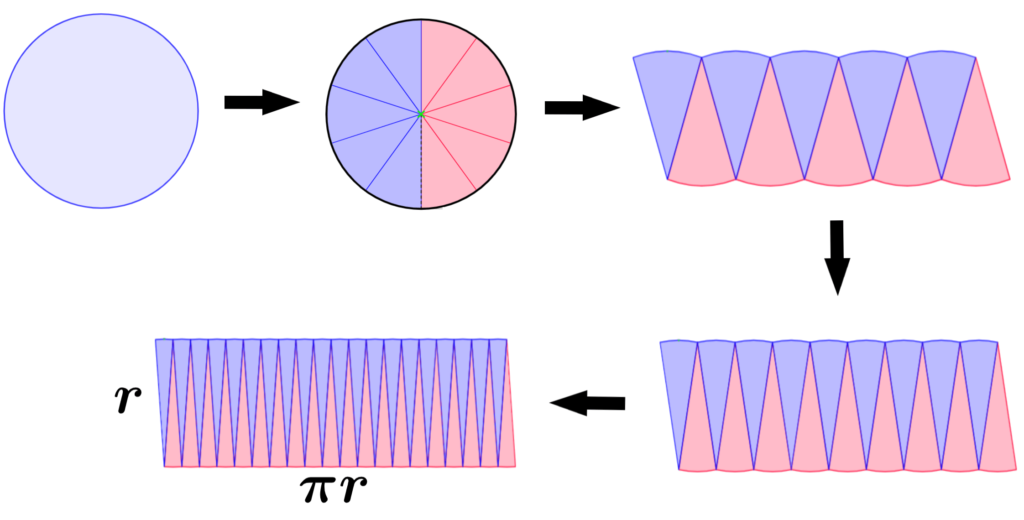The perimeter of a circle represents the length of the circle’s outline, that is, the perimeter is equal to the circumference. On the other hand, the area is a measure of the region occupied by the circle in the two-dimensional plane. The perimeter of a circle can be calculated using the formula C = 2πr and the area can be calculated using the formula A = πr², where r is the radius of the circle.
In this article, we will learn about the perimeter and area of a circle in detail. We will learn about its formulas and apply them to solve some practice problems.
GEOMETRY

Relevant for…
Learning about the perimeter and area of a circle with examples.
GEOMETRY

Relevant for…
Learning about the perimeter and area of a circle with examples.
How to find the perimeter of a circle?
We can calculate the perimeter of a circle, also known as the circumference, by multiplying the length of its diameter by the constant pi. Therefore, we have the following formula:
| $latex C=\pi d$ |
Here, d is the length of the diameter and π is a mathematical constant with a value of approximately 3.141592…
To understand the definition of π, we can consider the following circle:

As we already mentioned, the perimeter is equal to the circumference, since it is the length of the outline of the circle. Also, we see that the diameter is the distance that crosses the circle and passes through the center. The constant π is the ratio of the circumference to the diameter.
Therefore, the definition of π is as follows:
$latex \frac{C}{d}=\pi$
Rearranging the formula, we have the formula for the circumference or perimeter of the circle:
$latex C=\pi d$
Calculate the perimeter of a circle with the radius
To calculate the perimeter of a circle using the radius, we recall that the diameter is equal to 2r. Therefore, we can rewrite the perimeter formula as follows:
| $latex C=2\pi r$ |
How to find the area of a circle?
To calculate the area of a circle, we can multiply π by the radius of the circle squared. Therefore, we have the following formula:
| $latex A=πr^2$ |
Remember that the radius of a circle is the segment that joins the center of the circle with the circumference. The following is a circle with radius r:

Proof of the formula for the area of a circle
The formula for the area of a circle can be proved using various techniques. Some of the more advanced techniques include the use of Calculus. However, here we are going to simplify the demonstration a bit by using the following diagram:

If we cut the circle into several sectors, we can rearrange the sectors and form a parallelogram-shaped figure. If we make small enough cuts, we will eventually form a parallelogram.
If the number of sectors cut from the circle is increased, the parallelogram will eventually look like a rectangle with a base equal to πr and a height equal to r.
Since the area of a rectangle is equal to the length of its base multiplied by its height, we have:
$latex A=\pi r\times r$
$latex A=\pi {{r}^2}$
Calculate the area of a circle using the diameter
To calculate the area of a circle using the diameter, we remember that the diameter is equal to 2r. Equivalently, we can write $latex r=\frac{d}{2}$. Therefore, we use this equivalence in the formula for the area of a circle:
$latex A=\pi {{r}^2}$
$latex A=\pi {{(\frac{d}{2})}^2}$
| $latex A=\pi (\frac{{{d}^2}}{4})$ |
where, d is the length of the diameter.
Perimeter and area of a circle – Examples with answers
The formulas for the perimeter and area of a circle are used to solve the following examples. Try to solve the problems yourself before looking at the solution.
EXAMPLE 1
Find the perimeter of a circle that has a diameter of 6 feet.
Solution
We use the value $latex d=6$ in the formula for the perimeter in terms of the diameter:
$latex C=\pi d$
$latex C=\pi (6)$
$latex C=18.8$
The perimeter of the circle is equal to 18.8 ft.
EXAMPLE 2
If a circle has a radius of 5 inches, what is its area?
Solution
We are going to use the formula for the area in terms of the radius with the value $latex r=5$. Therefore, we have:
$latex A=\pi {{r}^2}$
$latex A=\pi {{(5)}^2}$
$latex A=\pi (25)$
$latex A=78.5$
The area of the circle is 78.5 in².
EXAMPLE 3
Find the perimeter of a circle that has a diameter of 15 in.
Solution
We apply the formula for the perimeter of a circle with the value $latex d=15$:
$latex C=\pi d$
$latex C=\pi (15)$
$latex C=47.1$
The perimeter is equal to 47.1 in.
EXAMPLE 4
Find the area of a circle that has a radius of 12 inches.
Solution
Using the formula for the area of a circle with the value $latex r=12$, we have:
$latex A=\pi {{r}^2}$
$latex A=\pi {{(12)}^2}$
$latex A=\pi (144)$
$latex A=452.4$
The area of the circle is 452.4 in².
EXAMPLE 5
Find the length of the perimeter of a circle that has a radius of 8 yd.
Solution
Here, we have the length of the radius instead of the diameter, so we use the value $latex r=8$ in the following formula:
$latex C=2\pi r$
$latex C=2\pi (8)$
$latex C=50.3$
The perimeter is equal to 50.3 yd.
EXAMPLE 6
Find the area of a circle that has a diameter of 10 ft.
Solution
We use the formula for the area of a circle in terms of the diameter with the value $latex d=10$:
$latex A=\pi(\frac{{{d}^2}}{4})$
$latex A=\pi(\frac{{{(10)}^2}}{4})$
$latex A=\pi(\frac{100}{4})$
$latex A=\pi(25)$
$latex A=78.5$
The area of the circle is 78.5 ft².
EXAMPLE 7
Find the perimeter of a circle that has a radius of 13 in.
Solution
We use the value $latex r=13$ in the formula for the perimeter of a circle. Therefore, we have:
$latex C=2\pi r$
$latex C=2\pi (13)$
$latex C=81.7$
The perimeter is equal to 81.7 in.
EXAMPLE 8
What is the area of a circle that has a diameter of 20 inches?
Solution
We are going to use the formula for the area of a circle in terms of the diameter. Therefore, we substitute the value $latex d=20$:
$latex A=\pi(\frac{{{d}^2}}{4})$
$latex A=\pi(\frac{{{(20)}^2}}{4})$
$latex A=\pi(\frac{400}{4})$
$latex A=\pi(100)$
$latex A=314.16$
The area of the circle is 314.16 in².
EXAMPLE 9
What is the diameter of a circle that has a perimeter of 100 feet?
Solution
In this example, we know the perimeter of the circle, and we are going to find the diameter, so we use the value $latex C=100$ in the formula and solve for d:
$latex C=\pi d$
$latex 100=\pi d$
$latex d=\frac{100}{\pi}$
$latex d=31.8$
The length of the diameter is equal to 31.8 ft.
EXAMPLE 10
Find the length of the radius of a circle that has an area of 150 in².
Solution
In this example, we know the area, and we are going to find the length of the radius. Therefore, we use the value $latex A=150$ in the area formula and solve for r:
$latex A=\pi {{r}^2}$
$latex 150=\pi {{r}^2}$
$latex {{r}^2}=\frac{150}{\pi}$
$latex {{r}^2}=47.75$
$latex r=6.91$
The radius of the circle is 6.91 in.
Perimeter and area of a circle – Practice problems
Solve the following problems using what you have learned about the perimeter and area of a circle. Click “Check” to make sure that you got the correct answer.
See also
Interested in learning more about the perimeter and area of geometric figures? Take a look at these pages:



